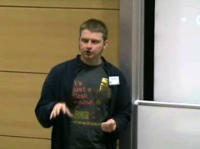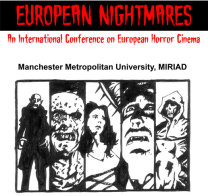Gérard Kraus
University of Wales, Aberystwyth
The Properties of “Kachkéis”* Cinema: Reception, Cultural Difference and the Luxembourgish Horror Film Subculture
*boiled cheese – a gooey and sticky Luxembourg cheese specialty

 Windows Media Video
Windows Media Video
[Download Windows Media Player]
Making sense of movies culturally involves getting to grips with frameworks on actual viewing perspectives (what viewpoint do audiences take when confronted with a film), receptions (how are films discussed in a public sphere) and production practices (how are films incepted in a culture). Janet Staiger’s approach to reception studies comes close in incorporating these questions into research into cinema . But Staiger’s concepts seem to prefer national –scale cinema products. When applied to either international cinema (especially in the form of coproductions) or decidedly local cinema (in the form of underground and subcultural cinema) new approaches seem necessary.
This paper seeks to broaden Staiger’s approach by looking at three levels of Luxembourgish horror film culture (international, national, and subcultural). Despite the fact that Luxembourg hosted the production of internationally renowned co-productions such as Dog Soldiers (Lux/UK) and Shadow of the Vampire (Lux/USA) it was only on Halloween 2005 that the first bona fide Luxembourgish Horror film, entitled Zombie Film, made its way to mainstream cinemas. Beyond, or rather beneath this, most prominent outing of the horror film in Luxembourg, I propose to have a look at other hardly distributed genre films such as Rendolepsis and Black King’s Way, made by independent filmmakers in Luxembourg, and the ways they are treated if the public eye notices them at all.
Working with three levels of cultural production, the dominant global, the national Luxembourgish and the specific horror subculture of the Grand Duchy, I intend to identify the relations that are made between these three, a difference that becomes apparent when comparing the public presence of the films. In extending Staiger’s framework I will make use of Charles Acland’s research on ‘felt internationalist’ cinema , and Gina Marchetti’s study of subcultural viewing environments to illustrate how producers, audiences, and critics find ways to address a genre generally seen to be far away from inherently Luxembourgish.

